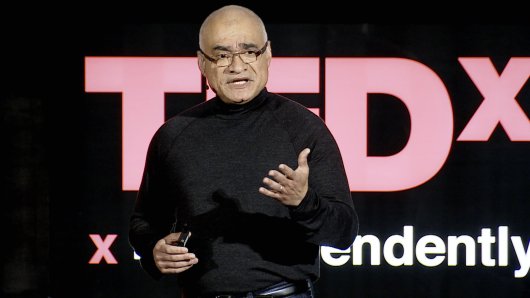We have all been there: standing in aisle five of the supermarket trying to decide which jar of mustard to buy. Do we go organic, or for the brand with whole mustard seeds? Or do we simply pick the one in the brightest yellow bottle?
In a fascinating talk at TEDxStanford, “Sometimes it’s good to give up the driver’s seat,” marketing professor Baba Shiv reveals that discomfort over making choices extends into medical decisions. Five years ago, Shiv’s wife was diagnosed with breast cancer.
“The most harrowing and agonizing part of the whole experience was that we were making decision after decision,” Shiv shares in his talk. “The wisdom of the ages is that when it comes to decisions of importance, it’s best to be in charge. But are there contexts where we’re far better off taking the passenger seat and having someone else drive?”
Shiv decided to test the theory on undergraduate students about to solve word puzzles. While one set of students was asked to chose between two teas — caffeinated or relaxing chamomile — the other group was told by the researchers which of the teas to drink. In the end, the students assigned a tea solved more puzzles than those who were given a choice. Shiv hypothesized that this is because making the choice allows a person to have doubt about their decision when faced with the prospect of immediate feedback.
Shiv’s thoughts on choice are counterintuitive. But his work is part of a growing body of research on choice. Below, more studies — many from TED speakers — which suggest that having a variety of options isn’t always what we need.
In a jam
TED speaker Sheena Iyengar, a professor at Columbia University, performed a classic experiment in the realm of choice studies in 1995. In the study — which she describes in her TEDTalk “How to Make Choosing Easier” — Iyengar presented shoppers in a gourmet market with a display of jams. At times, the display showed 24 varieties. At others, it included only six. Iyengar found that, yes, 60 percent of customers found themselves pulled to the large display while only 40 percent stopped at the small one. But with 24 possible options, consumers questioned themselves and only 3% made a jam purchase. At the small display, nearly a third of consumers who stopped by bought a jar of jam.
The pasta problem
Malcolm Gladwell also thinks extensively about choice, and in his riveting TEDTalk “Malcolm Gladwell on spaghetti sauce,” he describes a visionary who anticipated Iyengar’s findings more than a decade before they were made. Howard Moskowitz, a psychophysicist turned market researcher, was asked by Prego spaghetti sauce in the early ‘80s to help them revise their product line. And thus Moskowitz headed out on the road with 45 pasta sauces, asking thousands of Americans to rate each one. But, using knowledge gleaned from working for brands like Pepsi and Vlassic Pickles, Moskowitz recommended that — rather than offering a large number of the top-rated varieties — Prego look for simple trends in the data. In the end, Prego added to a single variety to its product line — extra chunky. The company made $600 million by giving consumers a targeted choice rather than unlimited options.
Life and death decisions
Like Shiv, Iyengar recently moved her focus onto the weighty decisions made in hospitals. In her TEDTalk “Sheena Iyengar on the Art of Choosing,” she describes a study conducted on parents in both France and the United States who’d been faced with the horrible decision to take their infant off of life support. In the United States, this decision rests on the parents. However, in France, this decision is made by medical professionals. Iyengar and her fellow researchers looked at how the parents felt a year after in both countries. They found that while American parents harbored hugely negative emotions about the experience, the French parents were more able to reframe the tragedy with statements like, “Noah was here for so little time, but he taught us so much.” Still, American parents felt strongly that they would not have wanted their doctors to make the decision.
Financial times
In his blockbuster TEDTalk “Barry Schwartz on the paradox of choice,” the Swarthmore College professor quotes a study conducted by Iyengar and Emir Kamenica. The pair looked at the retirement savings choices made by half a million employees through the Vanguard Group. Analyzing the data, the pair found that for every 10 additional funds offered to an employee, the chances that an employee would invest in none of the above increased by 2.87%. Schwartz explained the significance in his talk. “With 50 funds to choose from, it’s so damn hard to decide which fund to choose that you’ll just put it off until tomorrow. And then tomorrow, and then tomorrow,” he said. “By not participating, they are passing up as much as $5,000 a year from the employer.”
Mo’ money, mo’ problems
Schwartz mentions another favorite study in his talk, from independent analysis done by David G. Myers of Hope College and Robert E. Lane of Yale University. In looking at market data, the two found that — even though the gross domestic product had doubled in the United States over a 30-year period — the proportion of the population describing themselves as “very happy” had declined by about 5 percent. This doesn’t sound like a huge shift, but the translation shows the significance: when given far more choice in life, 14 million Americans reported feeling less happy than their peers 30 years before.

Comments (65)
Pingback: Treat the Internet Like a Grocery Store - The Life of Pike
Pingback: Facing the Paradox of Choice in Your Career - Invincible Career
Pingback: The Bitterness of Having Overload Choices | Trick to Overcome the Effect – AMKN WORLD
Pingback: DiscoverNet | How Aldi Tricks You Into Spending More Money
Pingback: Offering a Limited Menu Can Maximize Your Profits (Demo) - Specialty Group